The ROG USB-BE92 is ASUS’s answer to the Nighthawk A9000 from NETGEAR. Both are quick ways to add tri-band Wi-Fi 7 to a Windows computer and share the same hardware specs.
In my trial, the ROG USB-BE92 has a clear advantage in ease of use and flexibility, thanks to its USB-C cradle and built-in software driver, while the NETGEAR has a tiny edge on performance thanks to the external antenna.
Here’s the bottom line: If you’re looking to add fast Wi-Fi 7 to your existing Windows computer, whether a laptop or desktop, the ASUS ROG USB-BE92 is an excellent buy. Get one today!
Dong’s note: I first published this post on Aug 20, 2024, as a preview and updated it to an in-depth review on August 21, 2025, after thorough hands-on testing.
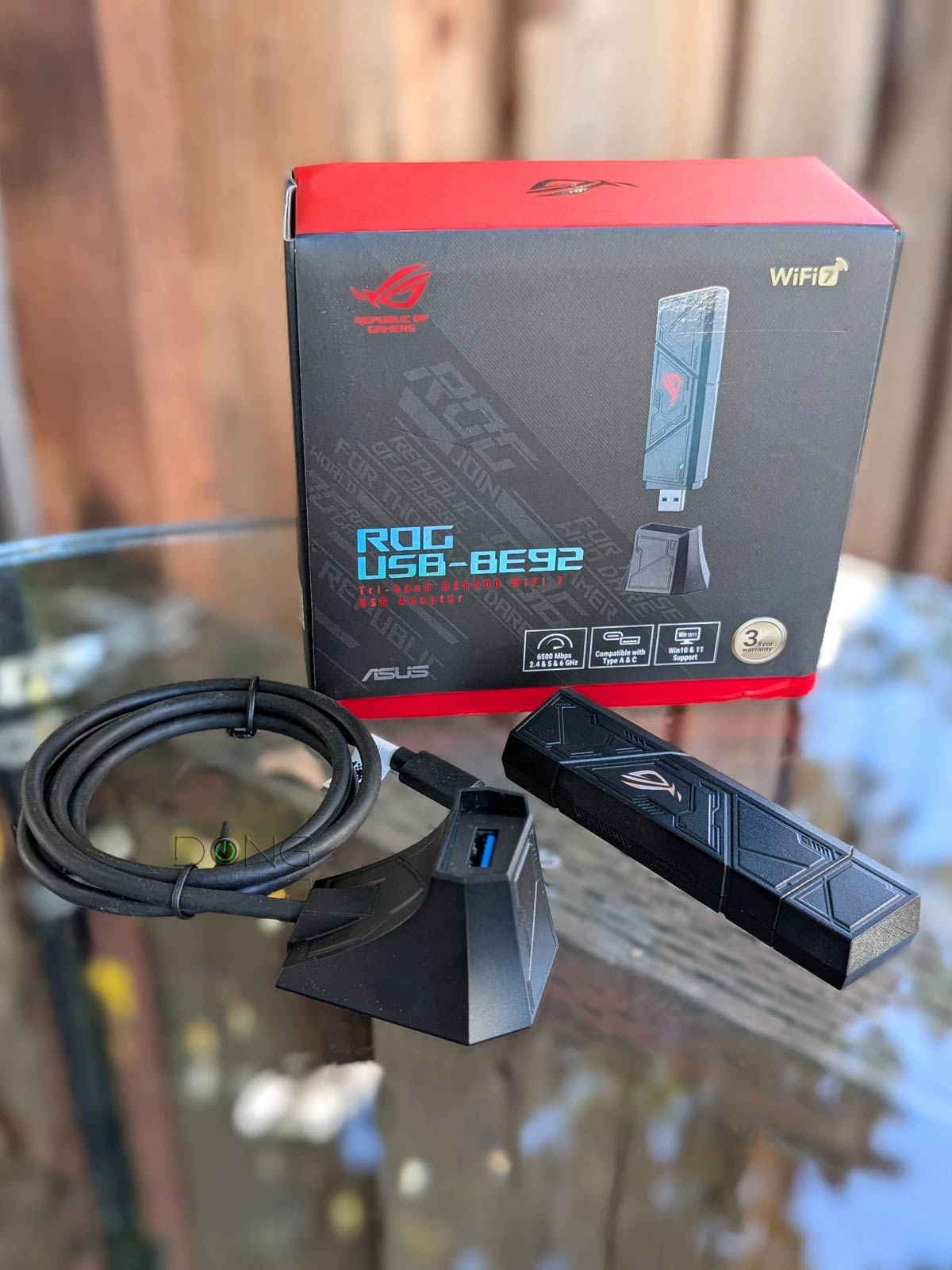
ASUS ROG USB-BE92: A Windows computer’s flexible Wi-Fi 7 friend
Like the case of the NETGEAR Nighthawk A9000, the ROG USB-BE92 is an easy alternative way to upgrade a computer to Wi-Fi 7 from the Intel BE200 or the Qualcomm NCM865 internal adapters. All you need is an available USB port on the machine.
On the downside, the ROG USB-BE92 features entry-level Wi-Fi 7 for an adapter. Similar to the case of the NETGEAR, it’s a tri-band adapter without support for 240MHz or wider channel width.
Having no colapsible antenna, the ASUS is also a bit bulkier and has slightly slower real-world rates over range, though not by much. The table below shows the detailed specs of the two USB Wi-Fi 7 adapters with the Intel BE200, which is more suitable for an internal upgrade, as a reference.
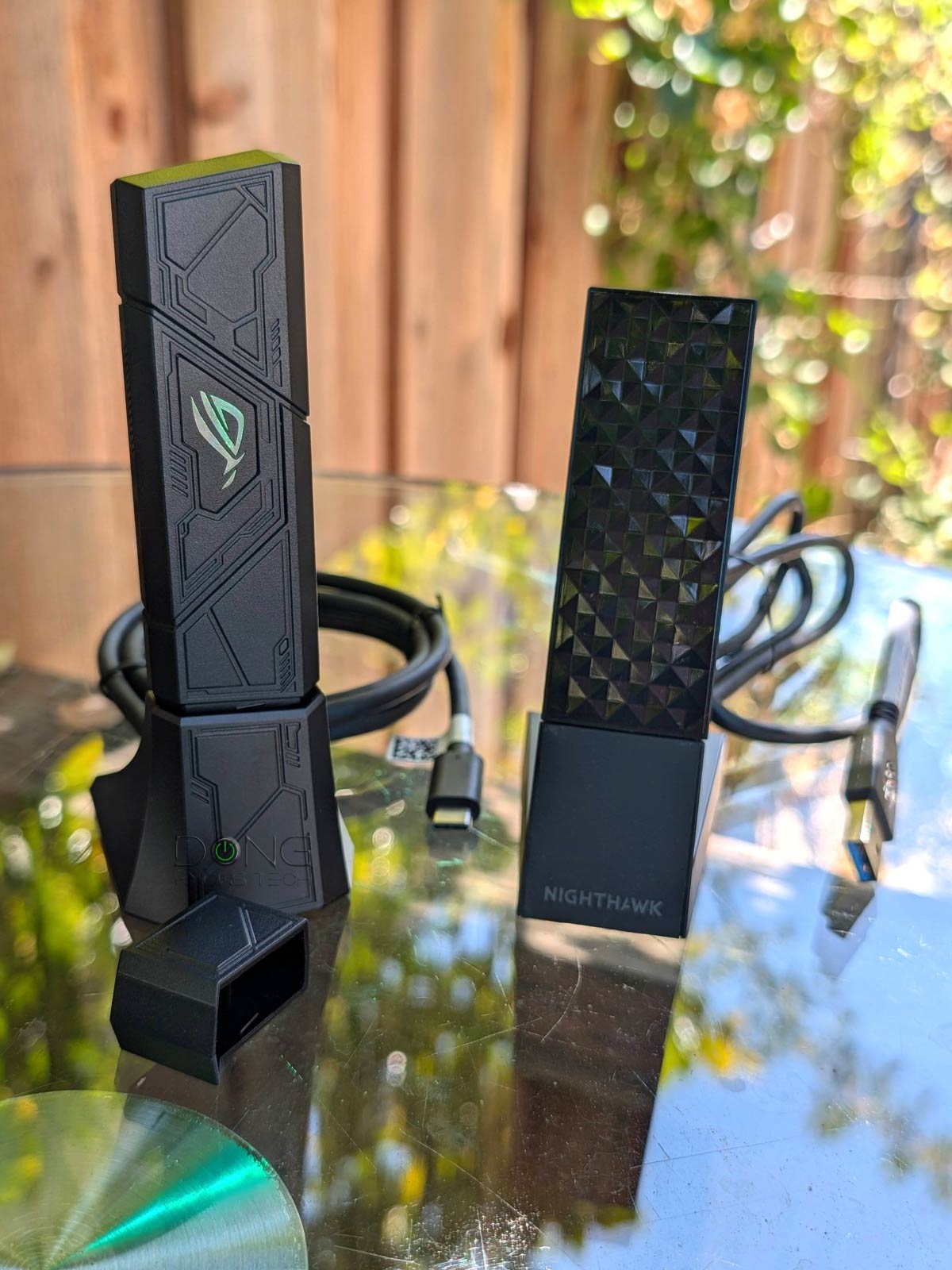
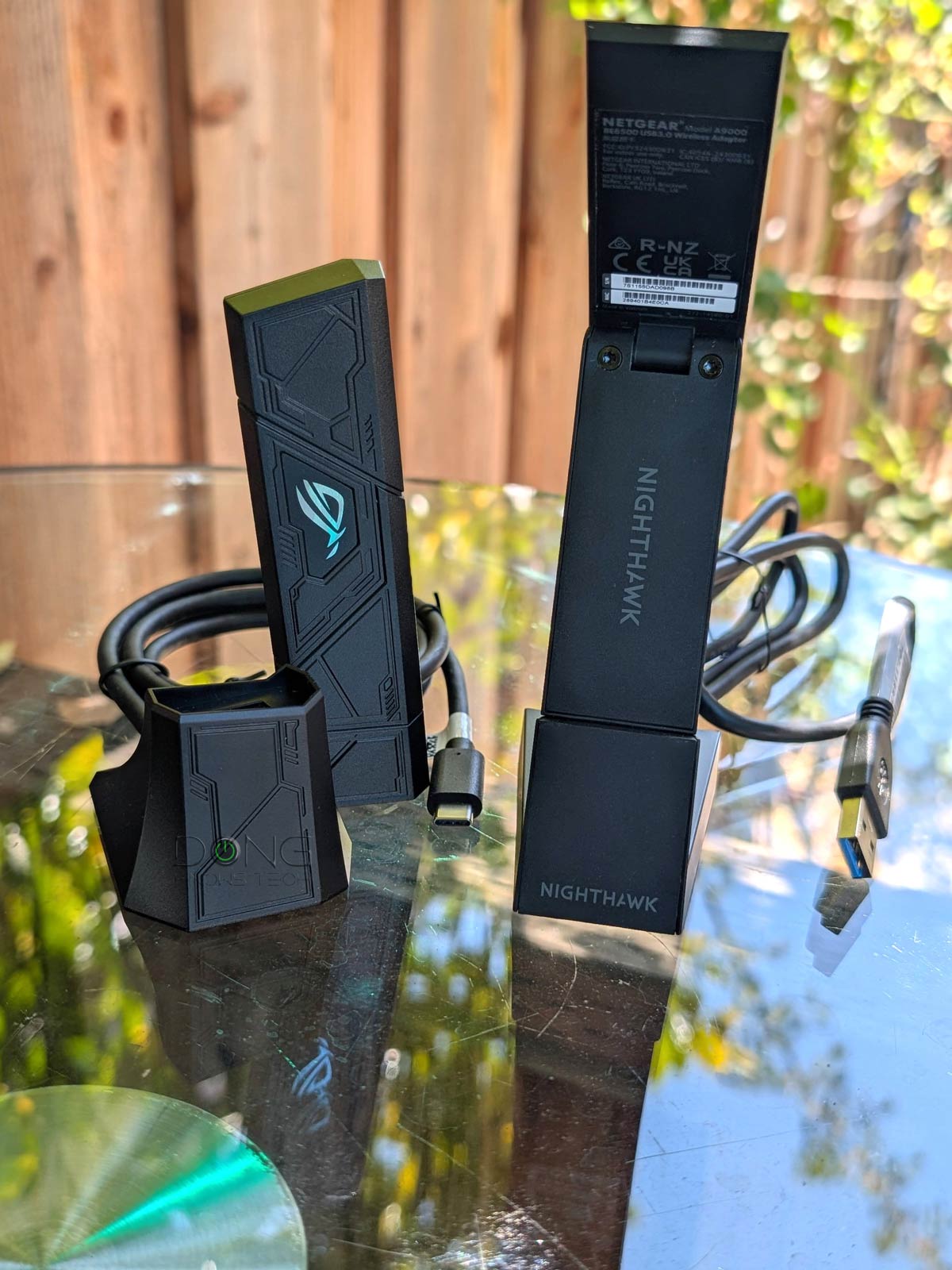
ASUS ROG USB-BE92 vs. NETGEAR Nighthawk A9000 vs. Intel BE200: Hardware specifications
 | 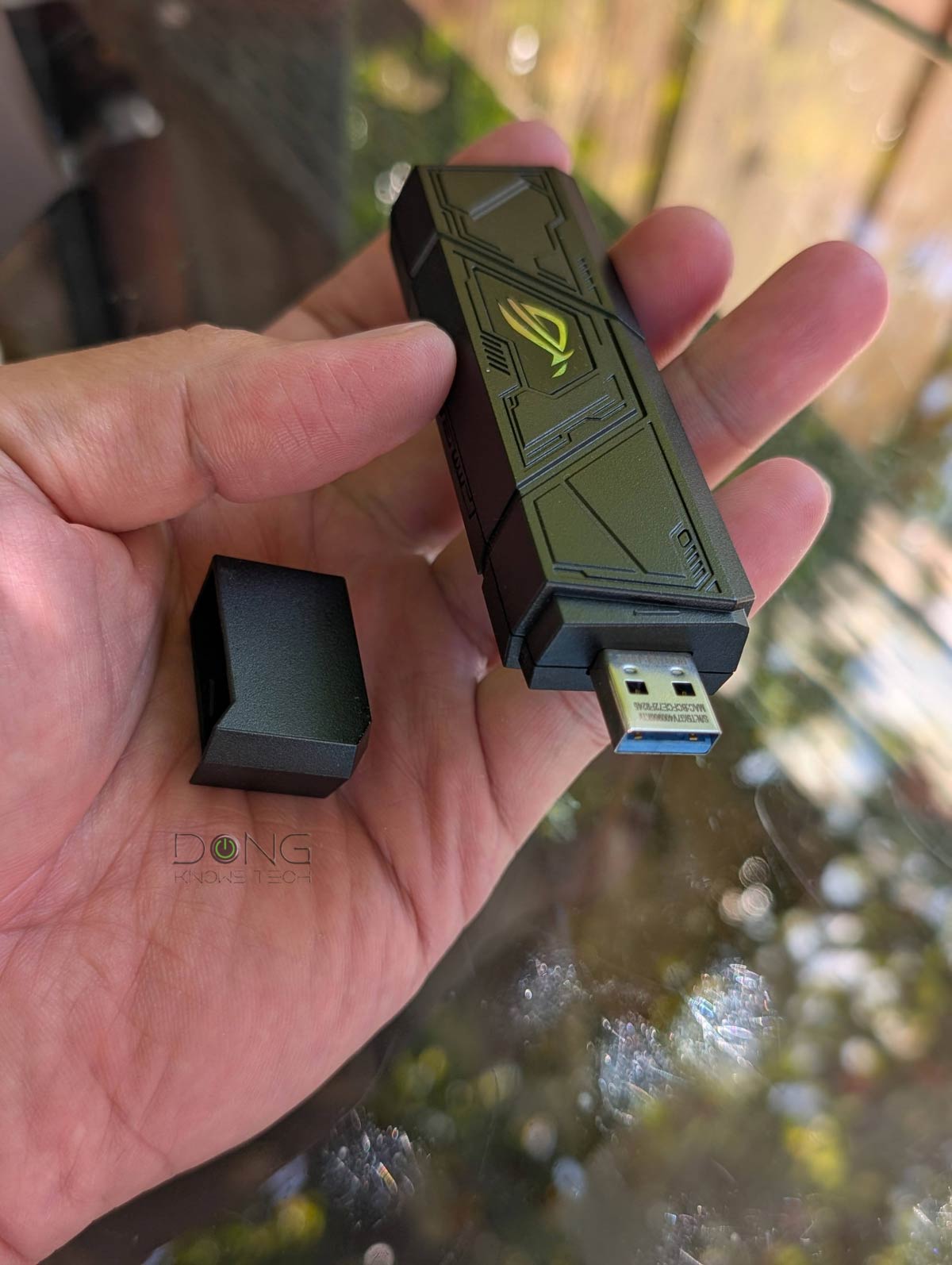 | 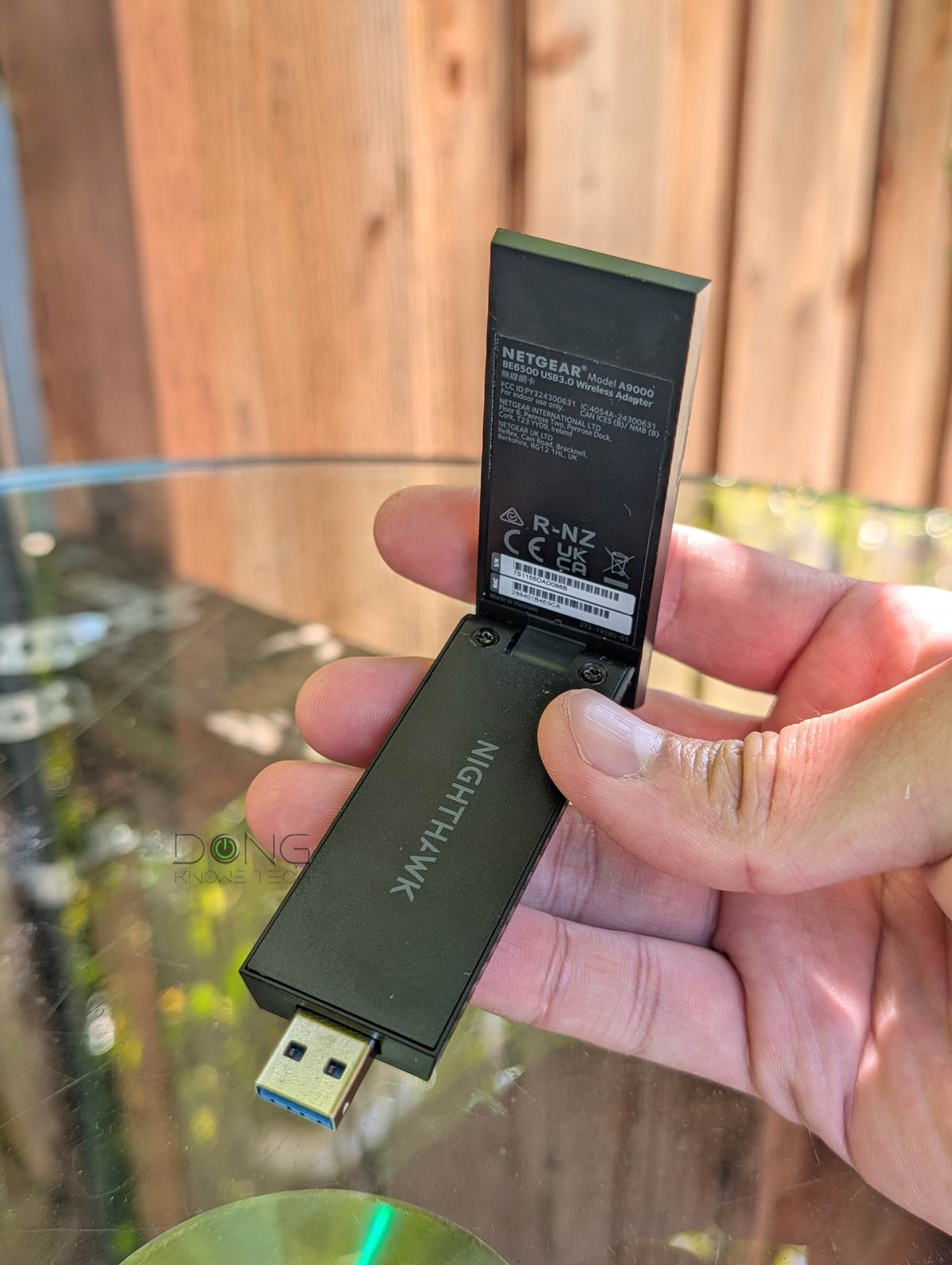 | |
|---|---|---|---|
| Name | Intel BE200 Wi-Fi 7 Adapter | ASUS ROG USB-BE92 Wi-Fi 7 USB Adapter | NETGEAR A9000 Nighthawk WiFi 7 USB 3.0 Adapter |
| Model | BE200 | ROG USB-BE92 | Nighthawk A9000 |
| Dimensions (adapter only) | M.2 2230 (22 x 30 x 2.4 mm), M.2 1216 (12 x 16 x 1.7 mm) | 4.41 x 0.66 x 1.18 in (112 x 16.8 x 30 mm) | 3.66 x 1.24 x 0.57 in (93.0 x 31.4 x 14.45 mm) |
| Weight | 0.15 g | 1.34 oz (38 g) | 0.99 oz (28 g) |
| Wi-Fi Bandwidth (theoretical) | Tri-band BE9500 | Tri-band BE6500 | |
| 2.4GHz Band (channel width) | 2×2 BE: Up to 688Mbps (20/40MHz) | ||
| 5GHz Band (channel width) | 2×2 BE: Up to 2882Mbps (20/40/80/160MHz) | ||
| 6GHz Band (channel width) | 2×2 BE: Up to 5763Mbps (20/40/80/160/320MHz) | 2×2 BE: Up to 2882Mbps (20/40/80/160MHz) | |
| Best Theoretical Wi-Fi Speed | 5763Mbps | 2882Mbps | |
| Security Support | WPA, WPA2, WPA3 | ||
| Bluetooth | 5.4 | None | |
| Interface | M.2 | USB 3.2. Gen 1 (5Gbps) USB 2.0 (reduced performance) | |
| Hardware Required | M.2 slot, PCIe adapter | USB-A port (adapter) USB-C port (cradle) | USB-A port |
| Driver Version (used for testing) | 23.60.1.2 | 2.0.0.5 | 20.1.6 |
| Platform Support | Win 11: 2.4GHz, 5Ghz, 6GHz (with Wi-Fi 7 features) Win 10: 2.4GHz, 5GHz | ||
| US Launch Price (Check street prices!) | $20-$60 | $99.99 | |


USB 3.0 with USB-C option, embedded software driver
As mentioned, out of the box, the most significant difference between the ASUS ROG USB-BE92 and the NETGEAR A9000 is the fact that the former comes with a cradle that uses USB-C. That makes it more flexible since you can use it with a (desktop) computer of either port type.
Other than that, the ASUS has an integrated antenna, making it a tad thicker and longer. As a USB adapter, it comes with a lid for its USB-A connector, which I misplaced within the first 24 hours. That happens.
What you won’t worry about misplacing is a thumb drive that holds the software driver, like the case of the NETGEAR A9000, because the ROG USB-BE92 doesn’t come with one. Instead, the adapter itself has an integrated 8MB flash drive that holds the software.
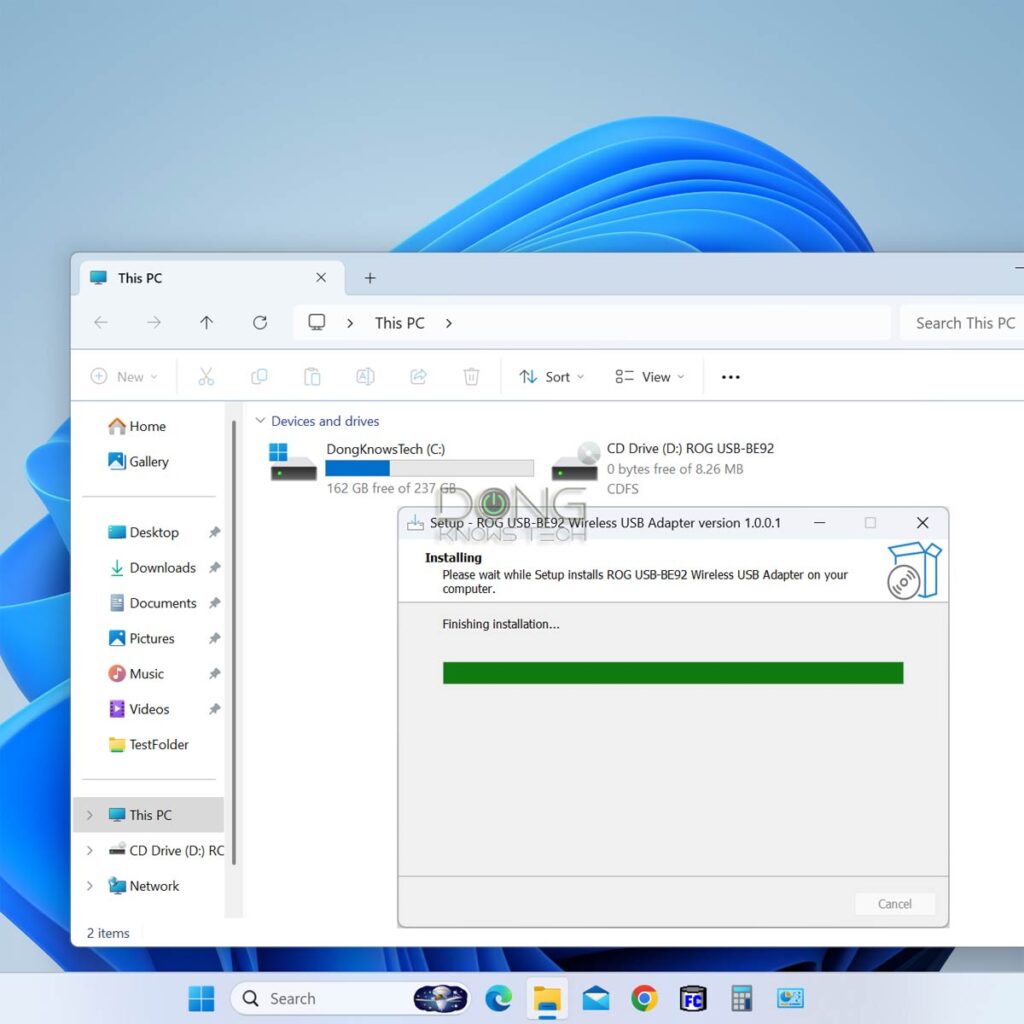
The first time you plug it into a Windows computer, this storage portion appears as a CD drive for users to install its software driver. After that, the CD never appears again until you plug the adapter into another computer that doesn’t already have the driver installed.
In any case, it’s best that you download and install the latest driver from ASUS, which is also the version I used for the testing.
ASUS ROG USB-BE92: Overall excellent performance
I tested the ASUS ROG USB-BE92 for a couple of days using it with both laptops and a desktop, and it generally worked as intended.
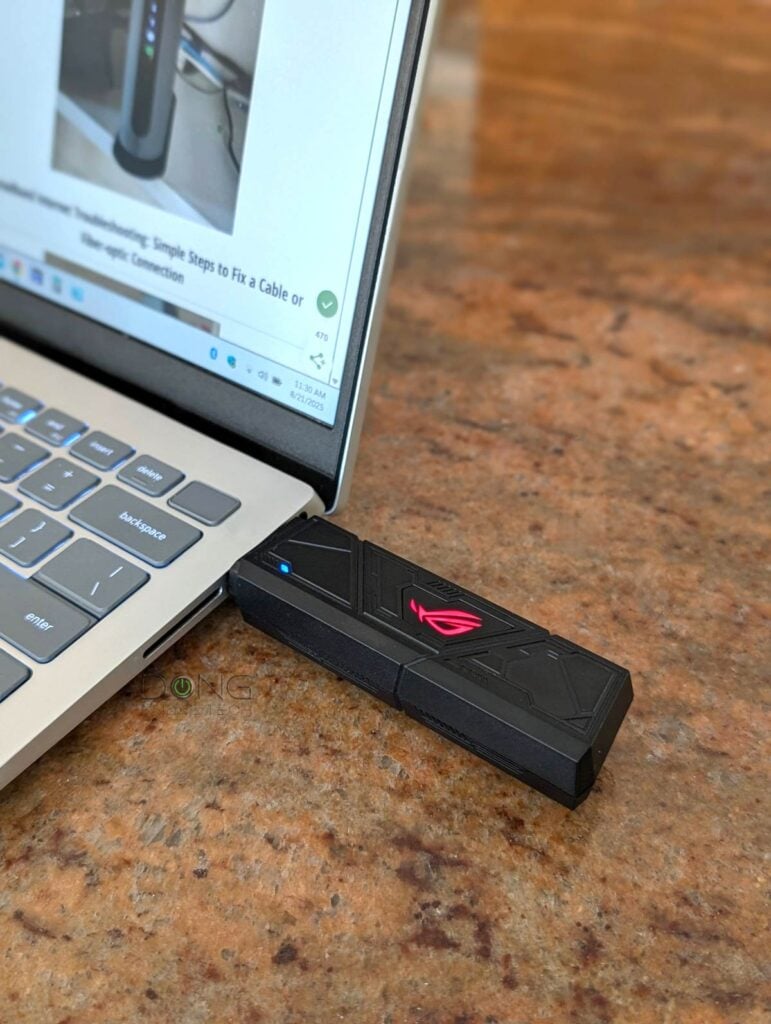
As supposedly a ROG gaming device, the adapter has an RGB light that glows red on top and a little flashing blue light to show the connection status. Both are subtle enough not to be a distraction.
In terms of real-world data rate, the ASUS ROG USB-BE92 proved to be generally the same as the NETGEAR counterpart, though if you look closely, it was slightly slower in some tests and slightly faster in others. Overall, the numbers were within the margin of error and not enough to decide which is faster.
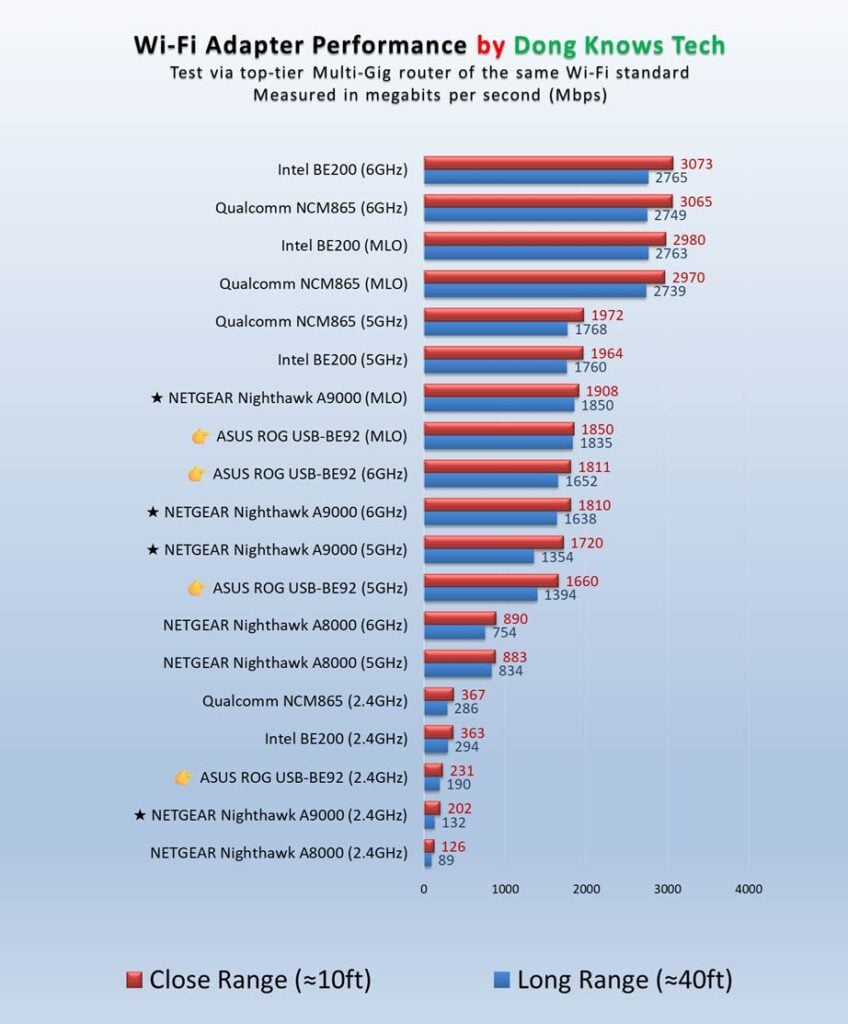
Other than that, the ASUS ROG USB-BE92 remained cool during operation. It proved to be a bit bulky for a laptop, but for a desktop, its size is perfect, especially with the included USB-C cradle.
ASUS ROG USB-BE92 Wi-Fi 7 USB Adapter's Rating
Pros
Quickly adds Wi-Fi 7 to a Windows computer with fast and reliable real-world performance
Built-in software driver for true plug-and-play
USB-C cradle included
Cons
Only works with Windows
No 240MHz or wider channel support
A bit bulky
Conclusion
While not a must-have, the ASUS ROG USB-BE92 is an easy Wi-Fi 7 upgrade for a Windows computer, especially a desktop that lacks Wi-Fi or supports an older standard.
The fact that it has an embedded software driver means you can also carry it around and add Wi-Fi 7 to any computer on demand. And that can come in handy. Get one today!



I’m only getting ~600 Mbits actual throughput with this thing. Tried it with it’s intended position 7 meters away from the adapter and moved it one meter away from the adapter for testing purposes. Windows reports 2882/2882 link speed with excellent signal strength. I’m getting ~55dbm signal with a 36 snr. The speeds should be twice that. But they’re not 🙁
Using the latest available Win11 driver 5102.24.126.2 dated July 15th.
Maybe that was your Internet speed, John? Speed testing can be tricky.
It was my internet speed, but it’s capped at 2 Gbit/s. I have since installed OpenWrt and iperf3 on an Asus BT8 router (3×3 wifi7). Using 160Mhz channels on a 6GHz network using ax/be (without mlo) I’m only getting 600ish. Fast.com did spike to 1.1/1.2./1.4 but it was for mere seconds in the dozens of tests I’ve done. 99.99% of the time throughput is capped at 600-650 for whatever reason.
Do you own one that behaves as expected (i.e 1.2/1.4 Gbit/s)?
It might be the USB port itself. I’d use check that first. Port grade, mode, bandwidth, power, and software driver. Restart the computer after you connect the adapter, etc.
It’s a normal front facing USB 3.0 case port connected to the (ancient) Z97-A mobo with a USB 3.0 header. Well capable of delivering the full 5 Gbit/s though.
I’d say try a different computer before drawing conclusions. No USB 3.0 port can deliver full 5Gbps.
Just bought this adapter, ran some speed tests…very disssapointed. My ASUS Pro Art X670E already has Wifi6E that hits 1200-1300mb/sec as is. This thing being gimped to 160mhz just like the iPhone 16 Pro Max is its death knell. I bought this thinking it would take me to the limit of my 2500mb/sec internet, just like my S24 Ultra can with its 320Mhz Wifi 7 adapter. Sad to see this thing was crippled right out the door. 160mhz Wifi 7 is quite literally no better then Wifi6E is. The added benefits of Wifi 7 don’t really matter if you can’t get the dang speed!
That’s how Wi-Fi 7 is, Ryan. The real question is why did you think it was “better”? Wi-Fi 7’s novelty is the new 320MHz channel width. 🤫
Hi Dong,
Any indication if this works with AMD CPUs?
It’s USB so it’s CPU-agnostic, Sean. You only need software driver for the OS and per Asus it officially supports Windows though that can change.
Will this work on my t450s laptop that has usb 3.0 and windows 10? I hear 6ghz sometimes doesn’t work on windows 10
It’ll “work” to an extent, Jonathan. As mentioned, you need Windows 11 24H2 and later to support Wi-Fi 7 fully, generally.
Hey Dong
Are you aware of any USB WiFi 7 dongles that are compatible with Apple Platforms that are either Intel or Apple CPU based?
No, Stuart, Apple is anal about driver and stuff so you’ll have to wait until it supports the standard. It’s generally far behind other platform on this front.
Apple sure is a laggard, all of this year’s new products and upgrades are Wi-Fi 6e at best. Their pace is pretty sad for a company what was once a WLAN leader.
If Asus uses in Intel chip rather than Qualcomm that’s going to be fail. Gigabyte theoretically offers either Qualcomm, Intel, or MediaTek for Wi-Fi 7, but the only stuff they’re actually shipping on MBs is MediaTek.
Thanks Dong. March 1st 2025 and it still has not released.
I have the Orbi RBR 770 Wifi 7 3 pack and tried the Realtek-based TP-Link wifi 7 USB adapter (available only at Best Buy I the US) and could NOT get it to connect to wifi 7, at least not directly (not even diagonally) on the other side of the house (pretty open floor plan) which is where I would use that laptop.
So hoping this Asus ROG adapter or the upcoming Acer Wave D7 adapter will work better / properly.
Please keep in mind that this is a discrete adapter commentary on board vendors’ use of chipsets for WiFi on a motherboard, which is entirely different in this respect. ASUS broadly uses Intel more than any other company across numerous products. With this noted, there can be other chipsets utilized. If you want to verify on the chipset, check the corresponding tech spec portion of the product you are looking at.